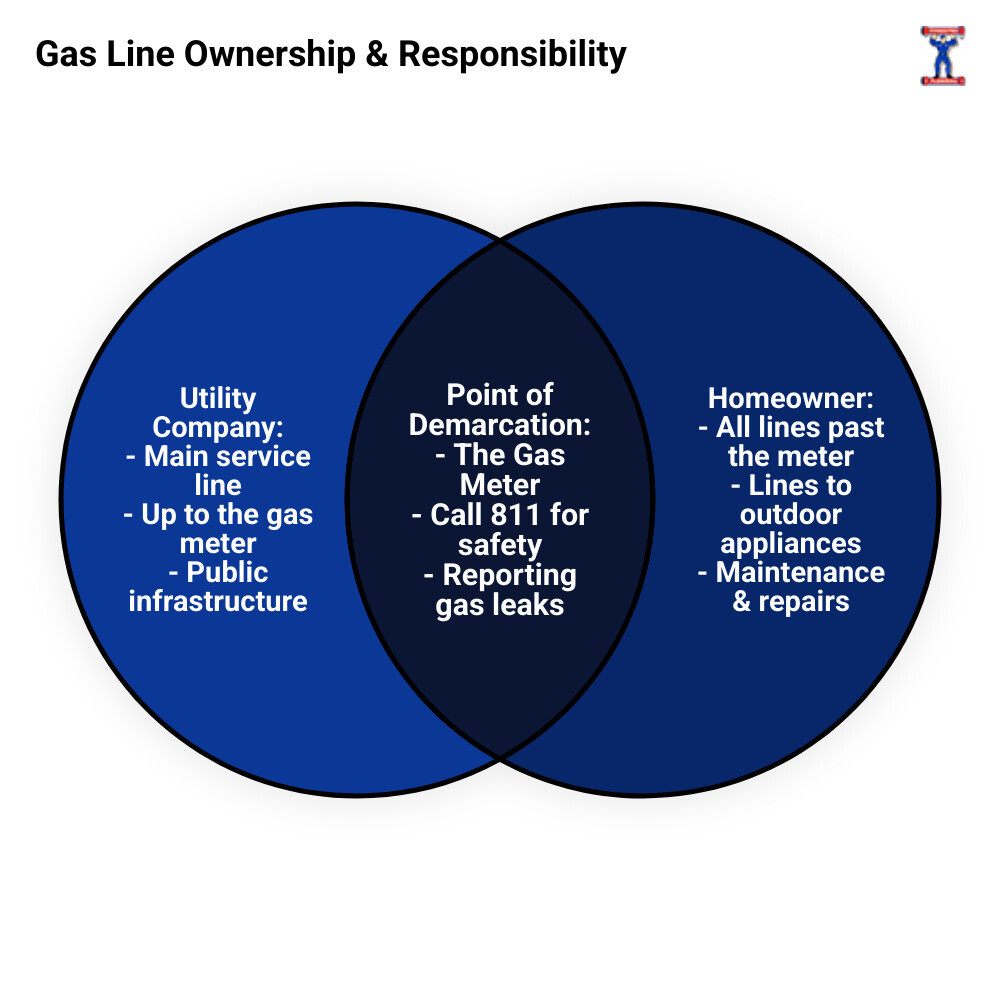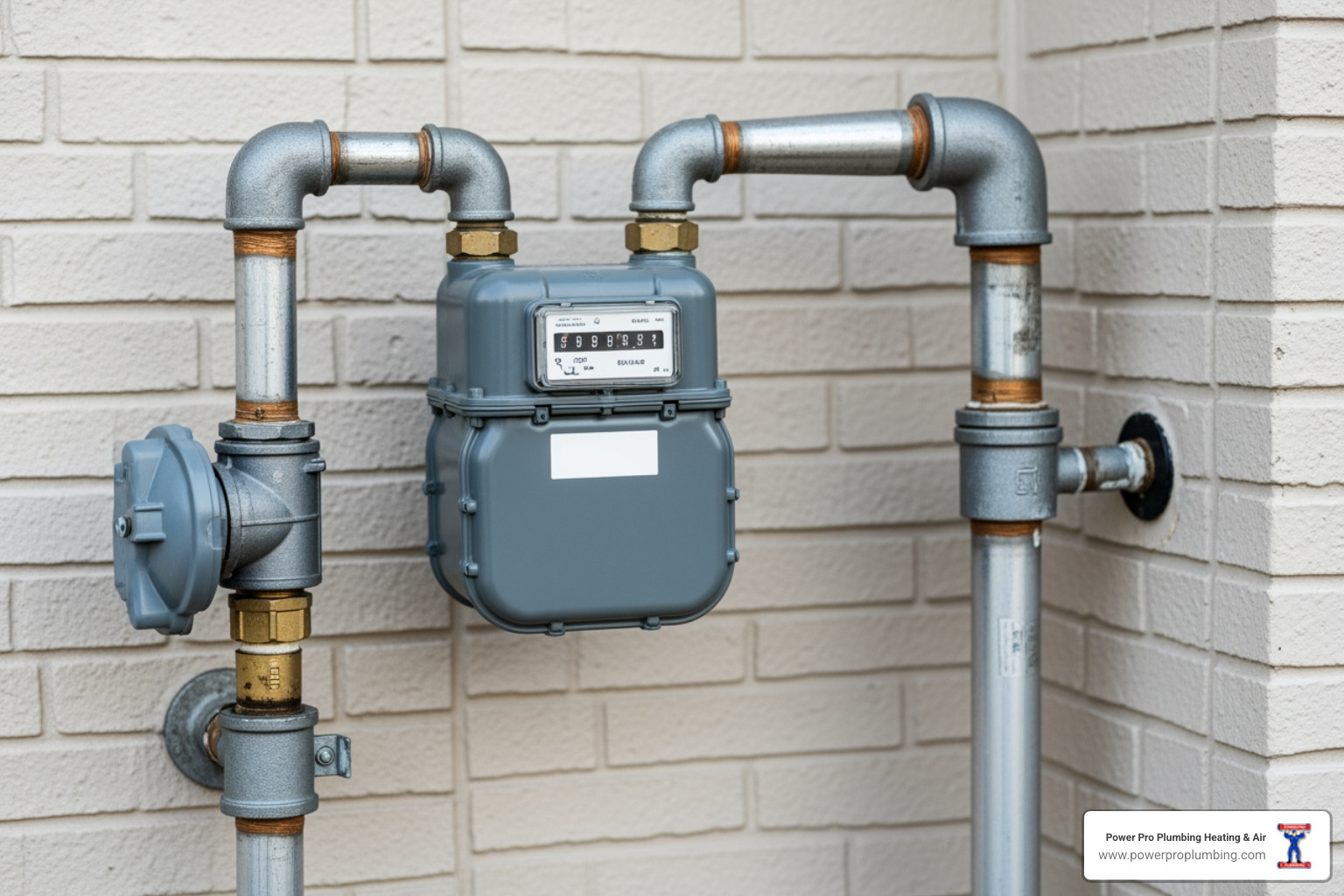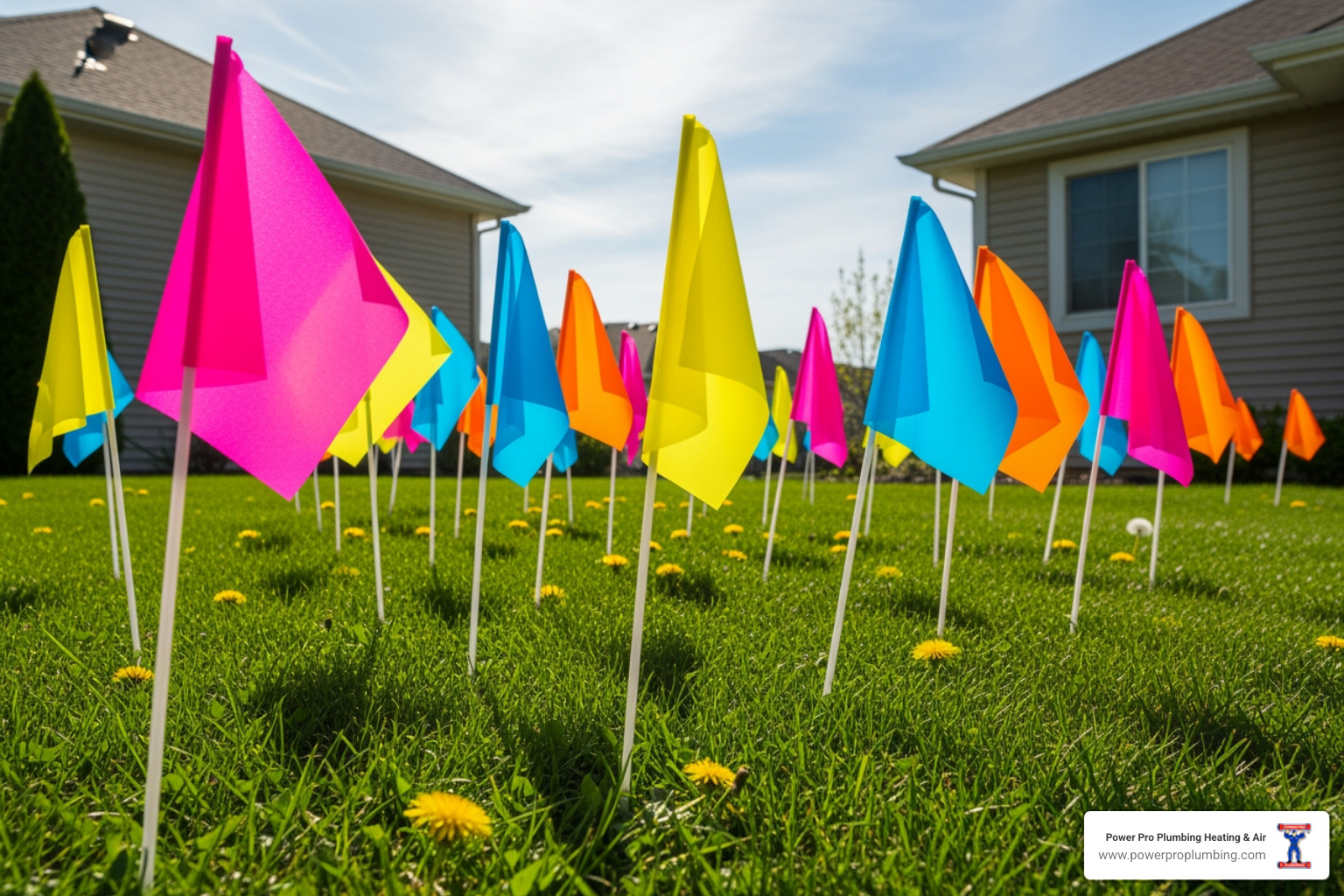
Why Your Gas Line Outside House Matters More Than You Think
A gas line outside house serves outdoor appliances like grills, fire pits, and pool heaters, but it also comes with serious safety responsibilities. If you're planning to install, maintain, or work near an exterior gas line, understanding what you're dealing with—and who's responsible for it—is essential before you pick up a shovel or paintbrush.
Quick Answer: What You Need to Know About Your Exterior Gas Line
- Ownership: You own and maintain all gas lines from the meter to your appliances
- Materials: Black iron, CSST (indoor), and HDPE (underground) are the approved options
- Safety First: Always call 811 before digging to mark underground utilities
- Common Uses: BBQ grills, fire pits, patio heaters, pool heaters, outdoor kitchens
- Warning Signs: Rotten egg smell, hissing sounds, dead vegetation, or higher bills
- Professional Help: Gas line work requires permits, inspections, and licensed contractors
Whether you're adding a natural gas grill to your patio or maintaining an existing line, the stakes are high. Gas leaks can cause fires, explosions, and carbon monoxide poisoning—making proper installation and maintenance non-negotiable. For comprehensive guidance on gas line safety and maintenance, check out our complete guide to gas line services. If you need immediate professional assistance with your outdoor gas line, our certified technicians are ready to help with expert installation and repair services.
I'm Daniel Rodriguez, a second-generation tradesman with C36 plumbing and C20 HVAC licenses, and I've helped countless Southern California homeowners safely install and maintain gas lines outside their houses. My family business has taught me that while outdoor gas appliances add tremendous value to your property, the safety protocols around them aren't optional—they're essential.

Understanding Your Exterior Gas Line: Ownership and Responsibility
Many homeowners are surprised to learn their gas company doesn't own or maintain all the gas lines on their property. An invisible line of responsibility runs through your yard, and knowing where it falls can prevent costly mistakes and dangerous situations.

What is a Customer-Owned Gas Line?
Your gas meter is the dividing line. The utility company owns and maintains the service line running from the street to your meter. Everything on the house side of that meter is your responsibility.
This customer-owned section, or "houseline," includes all piping from the meter to any appliance on your property. This includes lines to your indoor furnace and water heater, as well as the gas line outside house that powers your patio setup.
Your responsibility covers buried lines to pool and spa heaters, connections for your natural gas barbecue, outdoor gas lighting, fire pits, backup generators, and even gas lines to detached buildings. If it's past your meter, you must maintain it.
The point where the utility's responsibility ends and yours begins is the point of demarcation, which is almost always at the meter.
Why Maintenance is Your Responsibility
The logic is simple: the utility delivers gas to your property line but isn't responsible for what happens on private property. Maintaining these lines is a homeowner duty, just like caring for your roof or electrical system.
This isn't just a technicality; the safety implications are serious.
Buried gas lines face threats from corrosion, especially older metallic pipes. Soil moisture and time can create weak spots that eventually leak. Above-ground lines face weather exposure and physical damage.
A gas leak isn't a minor issue like a dripping faucet. It can lead to fires, explosions, and carbon monoxide poisoning—hazards that can turn deadly in minutes. There's also a safety liability issue; if a poorly maintained line on your property causes damage or injury, you could be held responsible.
Regular maintenance helps catch small problems before they become disasters, ensures your appliances function efficiently, and provides peace of mind.
If you notice unusual smells, dying patches of grass, or hissing sounds, don't wait. These could be signs of corrosion or leaks. Check out our guide on Signs of Corroded Gas Lines in Your Home to learn what to watch for, because when it comes to gas lines, what you don't know can hurt you.
Planning Your Outdoor Gas Line Installation
Adding a gas line outside house can transform your backyard, but this is not a DIY project. Natural gas demands respect and expertise. Proper planning, adherence to local building codes, and professional installation are essential for safety and long-term function.
Common Uses for an Exterior Gas Line
An outdoor natural gas line opens up many possibilities. BBQ grills with a permanent gas connection offer unlimited fuel and consistent heat, unlike propane tanks. Fire pits provide instant ambiance without the hassle of wood, smoke, or embers. Patio heaters keep your deck comfortable on cool evenings, extending your outdoor season.
For serious entertainers, outdoor kitchens can power ranges, pizza ovens, and more. Pool and spa heaters are another smart investment, as natural gas heats water efficiently for year-round enjoyment. Finally, gas lighting adds security and a warm, flickering ambiance to walkways and patios that electric lights can't replicate.
These installations add value to your property and provide a reliable, cost-effective fuel source that is also more environmentally friendly than many alternatives.
Choosing the Right Materials for a Gas Line Outside House
The material for your exterior gas line is critical for safety, longevity, and code compliance. The choice depends on whether the line is above or below ground, and local codes in the Los Angeles, Orange County, and South Bay areas have the final say.
| Material Type | Common Use | Durability | Corrosion Resistance | Notes |
|---|---|---|---|---|
| Black Iron Pipe | Most common for both interior and exterior, above-ground. | High | Low (requires protection) | Strong, heat-resistant, requires painting for outdoor exposure to prevent rust. |
| Corrugated Stainless Steel Tubing (CSST) | Primarily for indoor use, or outdoor with specific protection. | Moderate | High | Flexible, easier to install in tight spaces, but requires protection from mechanical damage if exposed outdoors. Some local codes may restrict its exterior use. |
| High-Density Polyethylene (HDPE) | Exclusively for underground, exterior use. | High | Excellent | Very flexible, durable, non-corrosive, resistant to punctures and cracks, can withstand higher pressure. |
Black iron pipe is a robust, heat-resistant, and widely approved choice. However, when used above ground outdoors, it must be painted to prevent rust. Unprotected pipe will corrode quickly.
Corrugated Stainless Steel Tubing (CSST) is flexible, making installation easier in tight spaces. While corrosion-resistant, its outdoor use requires protection from physical damage, often with a conduit. Local codes may restrict its exterior use, so verification is necessary.
For buried gas lines, High-Density Polyethylene (HDPE) is the gold standard. It's engineered for underground use and is flexible, durable, and immune to corrosion, punctures, and cracks. It's the best choice for lines running to a pool heater or detached garage.
A licensed professional can help you steer technical requirements and local codes to select the right material for your project.
The Crucial First Step: Safety Protocols Before Work Begins
Before any digging begins for a gas line installation, there is one non-negotiable step: calling 811. This free service in California, known as DigAlert, is designed to prevent disasters.

When you call 811 a few days before digging, utilities will mark the locations of underground lines like gas, water, and electric. These colorful markings are life-saving guides.
Accidentally hitting a gas line can cause explosions, fires, and service disruptions. Calling 811 is often a legal requirement; skipping it can lead to fines, liability for damages, and serious injuries. Even if you think you know where lines run, professional marking ensures accuracy. Always respect these markings and use careful hand excavation when digging nearby.
Furthermore, any change to a gas plumbing system requires a permit and inspection from your local building department. This safety net ensures the work meets stringent standards. Inspectors verify materials, connections, and overall compliance.
This is why hiring a licensed, gas-certified plumber is essential. Our certified professionals handle the permit process, coordinate inspections, and ensure your gas line outside house is installed safely and correctly. Cutting corners on this type of work is never worth the risk.
Safety and Maintenance for Your Gas Line Outside House
Installing a gas line outside house is just the beginning. Keeping it safe and functional is an ongoing responsibility. Unlike indoor pipes, exterior lines face rain, sun, soil, and other outdoor hazards.
Recognizing the Signs of a Gas Line Problem
Gas leaks can be subtle. Knowing the warning signs could save your life.

- Rotten egg smell: Utility companies add an odorant called mercaptan to natural gas. If you smell it, take it seriously.
- Hissing or whistling sounds: These noises near a gas line or appliance indicate gas escaping under pressure.
- Dead or dying vegetation: A line of brown grass or wilting shrubs can be a red flag, as leaking gas displaces oxygen in the soil and kills roots.
- Bubbling in wet ground: Unexplained bubbling in puddles or mud near a buried gas line suggests gas is escaping.
- Sudden spike in your gas bill: If your usage hasn't changed, a higher bill could mean a leak.
- Physical symptoms: Unexplained dizziness, nausea, or headaches when in your yard could be caused by carbon monoxide from a gas leak.
If you suspect a gas leak, evacuate immediately. Avoid anything that could create a spark (cell phones, light switches, cars). From a safe distance, call 911 and your gas utility company. For more details, read our article on why Gas Leak Detection is Crucial.
Protecting Your Gas Line Outside House from Hazards
Prevention is key to gas line safety. Your outdoor lines face unique threats that require proactive protection.
- Tree roots: Aggressive roots can damage buried gas lines. When landscaping, consider the mature size of trees and their root systems. Always call 811 before planting to know where lines are located.
- Physical damage: Lawnmowers, tools, and even patio furniture can damage above-ground pipes. Keep lines anchored securely, several inches off the ground, and routed away from high-traffic areas.
- Corrosion: This is the silent enemy of black iron pipes. Exposed pipes must be painted to create a moisture barrier and prevent rust. For buried lines, using non-corrosive HDPE is the best defense.
- Sleeving: When a gas line passes through a rigid structure like concrete, it needs a protective sleeve. This larger pipe prevents abrasion and allows for movement without stress.
Regular professional inspections are crucial. A licensed contractor can identify hidden issues, test pressure, and check for corrosion, ensuring your system is safe. This preventive maintenance is essential for a system where neglect can have serious consequences.
Frequently Asked Questions about Exterior Gas Lines
Over the years, I've found that homeowners in the Los Angeles area tend to have similar questions when it comes to their outdoor gas systems. Let me address the most common concerns we hear at Power Pro Plumbing Heating & Air.
Who is responsible for the gas line from the meter to my house?
This is probably the question we get asked most often, and the answer surprises many homeowners. You, the property owner, are responsible for all gas piping on the "house side" of the gas meter. This includes any lines running from the meter into your home and to any outdoor appliances like grills or pool heaters.
Your utility company—whether that's SoCalGas, Long Beach Utilities, or another provider—maintains the main gas lines in the street and the service line that brings gas to your property. But their responsibility ends at the meter. Everything beyond that point is your customer-owned houseline, and you're responsible for maintaining, inspecting, and repairing it.
Think of the gas meter as the dividing line between their world and yours. It's a critical distinction because if something goes wrong with your gas line outside house or inside it, you can't call the utility company to fix it—you'll need to contact a licensed professional like our team.
Can I run a gas line above ground on the side of my house?
Yes, absolutely! Running a gas line outside house along the exterior—say, up a side wall or under the fascia—is a common and perfectly acceptable solution. However, there's a catch: it must be done with approved materials and installed strictly according to local codes.
For above-ground exterior runs, black iron pipe is typically the go-to choice. It needs to be properly secured to prevent movement, protected from physical damage (like from ladders or garden tools), and painted to prevent rust and corrosion. That paint job isn't just for looks—it's essential protection against the elements.
While flexible lines like CSST can sometimes be used outdoors, they often require additional protection, such as being enclosed in a conduit or chase, especially if they're exposed to potential mechanical damage. Local regulations vary, so it's crucial to verify what's allowed in your specific area with a licensed plumber before starting any work.
What should I do if I smell gas outside?
This is the most important question, and I want you to remember this answer. If you smell that distinctive "rotten egg" odor of natural gas outside your house, don't hesitate—act immediately.
First, leave the area right away. Move everyone away from the suspected leak to a safe distance. Don't try to investigate or find the source yourself.
Second, and this is critical: do not create a spark. That means no cell phones, no light switches, no electrical appliances, no lighters, and don't start any vehicles. Even a tiny spark can ignite escaping gas.
Third, call for help from a safe location. Once you're well away from the area, immediately call 911 and your gas utility company to report the potential leak. Give them your address and describe what you're experiencing. Do not re-enter the area until emergency responders or the utility company confirms it's safe.
Your safety is always our top priority. We've seen what gas leaks can do, and we want every homeowner to know these steps by heart. If you have any concerns about your gas line after an emergency has been resolved, our certified technicians are here to help ensure your system is safe and functioning properly.
Get Professional Help for Your Outdoor Gas Line Needs
A gas line outside house can transform your backyard into an entertainer's paradise—imagine never running out of propane mid-barbecue or enjoying a cozy fire pit at the flip of a switch. But here's the reality: this isn't a YouTube tutorial project. Gas line work demands expertise, precision, and strict adherence to safety standards that can literally be the difference between a beautiful outdoor space and a dangerous situation.
From the moment you start planning, you need professional guidance. A licensed gas contractor will assess whether your project is even feasible—not every outdoor space is suitable for a gas line, and not every appliance location makes sense from a safety or code perspective. They'll help you choose the right materials for your specific application, whether that's black iron pipe for an above-ground run or HDPE for a buried line to your pool heater.
Then there's the permitting process. Every gas line installation requires permits and inspections from your local building department. It's not red tape for the sake of bureaucracy—it's a critical safety checkpoint. A certified professional knows exactly what your municipality requires and will ensure the work meets or exceeds those standards. They'll also coordinate the mandatory inspections that verify everything is installed safely and correctly.
The stakes are simply too high to cut corners. A poorly installed gas line can leak, potentially causing fires, explosions, or carbon monoxide poisoning. Even small mistakes—like using the wrong sealant, inadequate support for above-ground pipes, or failing to properly protect a buried line—can create hazards that might not surface for months or years.
And once your gas line is installed, the relationship with your plumber shouldn't end there. Regular maintenance and periodic inspections are essential to keeping your system safe and reliable. Environmental factors like soil shifts, tree root growth, and weather exposure can all impact your exterior gas lines over time.
For expert gas line services throughout the greater Los Angeles area—from initial consultation and professional installation to ongoing maintenance and emergency repairs—trust the certified professionals at Power Pro Plumbing Heating & Air. Our team brings decades of combined experience, proper licensing (including C36 plumbing certification), and an unwavering commitment to safety. With over 28,573 online reviews, we've earned our reputation as industry leaders by treating every gas line project with the seriousness it deserves.
Whether you're in Long Beach, Cerritos, Torrance, Pasadena, Irvine, or anywhere in our extensive service area across Los Angeles, Orange County, and the South Bay, we're ready to help you safely enjoy the convenience and comfort of outdoor gas appliances. Contact us for your gas line installation and repair needs and experience the peace of mind that comes from working with true professionals who put your safety first.

